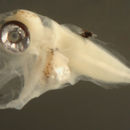Description
provided by World Register of Marine Species
Schools in near-surface waters as well as below the thermoclime, with temperatures between 18° and 31°C, primarily by size, either in monospecific or multispecies groups. Larger fish frequently school with porpoises, also associated with floating debris and other objects. Feeds on fishes, crustaceans and squids. It is sensitive to low concentrations of oxygen and therefore is often limited to depths of 100 m (Ref. 9340). Peak spawning occurs during the summer, in batches (Ref. 9684). Pole-and-line fishing is still one of the major surface fishing techniques while longlining fishing method is for deep swimming yellowfin tuna. Encirling nets are employed to catch schools near the surface (Ref. 9340). Marketed mainly frozen and canned (Ref. 9684), but also fresh (Ref. 9340) and smoked (Ref. 9987).
Froese, R. & D. Pauly (Editors). (2023). FishBase. World Wide Web electronic publication. version (02/2023).
- license
- cc-by-4.0
- copyright
- WoRMS Editorial Board
Diet
provided by World Register of Marine Species
Feed on fishes, crustaceans and squids. It is sensitive to low concentrations of oxygen and therefore is not usually caught below 250 m in the tropics
North-West Atlantic Ocean species (NWARMS)
- license
- cc-by-4.0
- copyright
- WoRMS Editorial Board
Distribution
provided by World Register of Marine Species
Worldwide in tropical and subtropical seas, but absent from the Mediterranean Sea
North-West Atlantic Ocean species (NWARMS)
- license
- cc-by-4.0
- copyright
- WoRMS Editorial Board
Habitat
provided by World Register of Marine Species
An oceanic species occurring above and below the thermoclines. They school primarily by size, either in monospecific or multispecies groups. Larger fish frequently school with porpoises, also associated with floating debris and other objects.
North-West Atlantic Ocean species (NWARMS)
- license
- cc-by-4.0
- copyright
- WoRMS Editorial Board
Habitat
provided by World Register of Marine Species
nektonic
North-West Atlantic Ocean species (NWARMS)
- license
- cc-by-4.0
- copyright
- WoRMS Editorial Board
Habitat
provided by World Register of Marine Species
Known from seamounts and knolls
Stocks, K. 2009. Seamounts Online: an online information system for seamount biology. Version 2009-1. World Wide Web electronic publication.
- license
- cc-by-4.0
- copyright
- WoRMS Editorial Board

